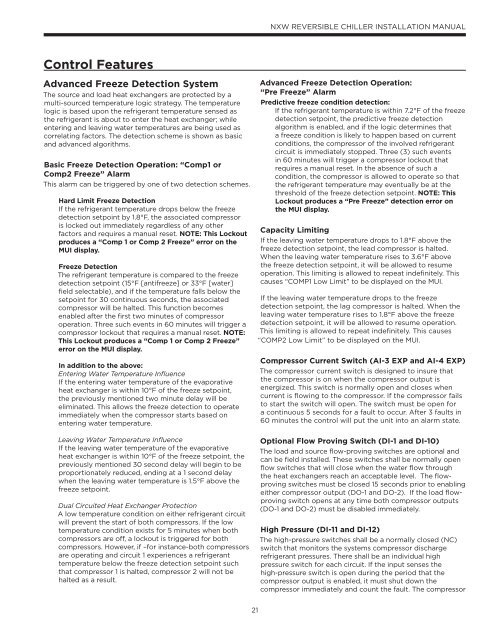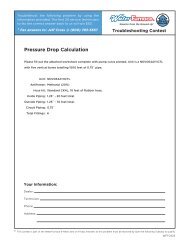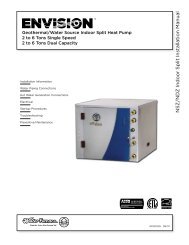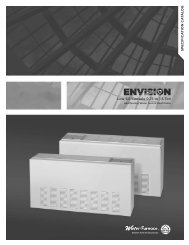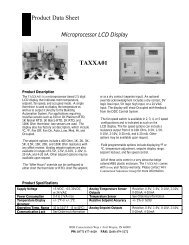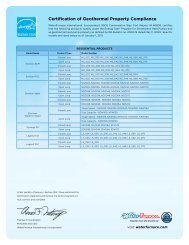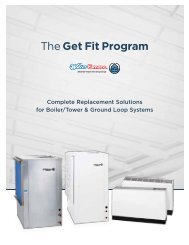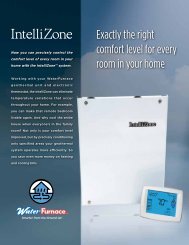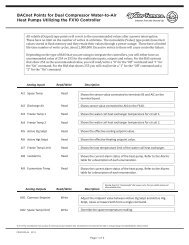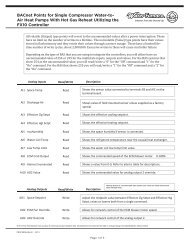NX W R e v ersible Chiller Installation Manual - WaterFurnace
NX W R e v ersible Chiller Installation Manual - WaterFurnace
NX W R e v ersible Chiller Installation Manual - WaterFurnace
You also want an ePaper? Increase the reach of your titles
YUMPU automatically turns print PDFs into web optimized ePapers that Google loves.
<strong>NX</strong>W REVERSIBLE CHILLER INSTALLATION MANUAL<br />
Control Features<br />
Advanced Freeze Detection System<br />
The source and load heat exchangers are protected by a<br />
multi-sourced temperature logic strategy. The temperature<br />
logic is based upon the refrigerant temperature sensed as<br />
the refrigerant is about to enter the heat exchanger; while<br />
entering and leaving water temperatures are being used as<br />
correlating factors. The detection scheme is shown as basic<br />
and advanced algorithms.<br />
Basic Freeze Detection Operation: “Comp1 or<br />
Comp2 Freeze” Alarm<br />
This alarm can be triggered by one of two detection schemes.<br />
Hard Limit Freeze Detection<br />
If the refrigerant temperature drops below the freeze<br />
detection setpoint by 1.8°F, the associated compressor<br />
is locked out immediately regardless of any other<br />
factors and requires a manual reset. NOTE: This Lockout<br />
produces a “Comp 1 or Comp 2 Freeze” error on the<br />
MUI display.<br />
Freeze Detection<br />
The refrigerant temperature is compared to the freeze<br />
detection setpoint (15°F [antifreeze] or 33°F [water]<br />
field selectable), and if the temperature falls below the<br />
setpoint for 30 continuous seconds, the associated<br />
compressor will be halted. This function becomes<br />
enabled after the first two minutes of compressor<br />
operation. Three such events in 60 minutes will trigger a<br />
compressor lockout that requires a manual reset. NOTE:<br />
This Lockout produces a “Comp 1 or Comp 2 Freeze”<br />
error on the MUI display.<br />
In addition to the above:<br />
Entering Water Temperature Influence<br />
If the entering water temperature of the evaporative<br />
heat exchanger is within 10°F of the freeze setpoint,<br />
the previously mentioned two minute delay will be<br />
eliminated. This allows the freeze detection to operate<br />
immediately when the compressor starts based on<br />
entering water temperature.<br />
Leaving Water Temperature Influence<br />
If the leaving water temperature of the evaporative<br />
heat exchanger is within 10°F of the freeze setpoint, the<br />
previously mentioned 30 second delay will begin to be<br />
proportionately reduced, ending at a 1 second delay<br />
when the leaving water temperature is 1.5°F above the<br />
freeze setpoint.<br />
Dual Circuited Heat Exchanger Protection<br />
A low temperature condition on either refrigerant circuit<br />
will prevent the start of both compressors. If the low<br />
temperature condition exists for 5 minutes when both<br />
compressors are off, a lockout is triggered for both<br />
compressors. However, if –for instance-both compressors<br />
are operating and circuit 1 experiences a refrigerant<br />
temperature below the freeze detection setpoint such<br />
that compressor 1 is halted, compressor 2 will not be<br />
halted as a result.<br />
Advanced Freeze Detection Operation:<br />
“Pre Freeze” Alarm<br />
Predictive freeze condition detection:<br />
If the refrigerant temperature is within 7.2°F of the freeze<br />
detection setpoint, the predictive freeze detection<br />
algorithm is enabled, and if the logic determines that<br />
a freeze condition is likely to happen based on current<br />
conditions, the compressor of the involved refrigerant<br />
circuit is immediately stopped. Three (3) such events<br />
in 60 minutes will trigger a compressor lockout that<br />
requires a manual reset. In the absence of such a<br />
condition, the compressor is allowed to operate so that<br />
the refrigerant temperature may eventually be at the<br />
threshold of the freeze detection setpoint. NOTE: This<br />
Lockout produces a “Pre Freeze” detection error on<br />
the MUI display.<br />
Capacity Limiting<br />
If the leaving water temperature drops to 1.8°F above the<br />
freeze detection setpoint, the lead compressor is halted.<br />
When the leaving water temperature rises to 3.6°F above<br />
the freeze detection setpoint, it will be allowed to resume<br />
operation. This limiting is allowed to repeat indefinitely. This<br />
causes “COMP1 Low Limit” to be displayed on the MUI.<br />
If the leaving water temperature drops to the freeze<br />
detection setpoint, the lag compressor is halted. When the<br />
leaving water temperature rises to 1.8°F above the freeze<br />
detection setpoint, it will be allowed to resume operation.<br />
This limiting is allowed to repeat indefinitely. This causes<br />
“COMP2 Low Limit” to be displayed on the MUI.<br />
Compressor Current Switch (AI-3 EXP and AI-4 EXP)<br />
The compressor current switch is designed to insure that<br />
the compressor is on when the compressor output is<br />
energized. This switch is normally open and closes when<br />
current is flowing to the compressor. If the compressor fails<br />
to start the switch will open. The switch must be open for<br />
a continuous 5 seconds for a fault to occur. After 3 faults in<br />
60 minutes the control will put the unit into an alarm state.<br />
Optional Flow Proving Switch (DI-1 and DI-10)<br />
The load and source flow-proving switches are optional and<br />
can be field installed. These switches shall be normally open<br />
flow switches that will close when the water flow through<br />
the heat exchangers reach an acceptable level. The flowproving<br />
switches must be closed 15 seconds prior to enabling<br />
either compressor output (DO-1 and DO-2). If the load flowproving<br />
switch opens at any time both compressor outputs<br />
(DO-1 and DO-2) must be disabled immediately.<br />
High Pressure (DI-11 and DI-12)<br />
The high-pressure switches shall be a normally closed (NC)<br />
switch that monitors the systems compressor discharge<br />
refrigerant pressures. There shall be an individual high<br />
pressure switch for each circuit. If the input senses the<br />
high-pressure switch is open during the period that the<br />
compressor output is enabled, it must shut down the<br />
compressor immediately and count the fault. The compressor<br />
21


